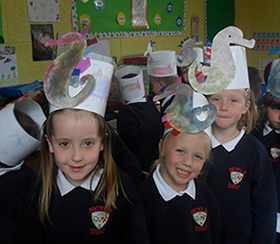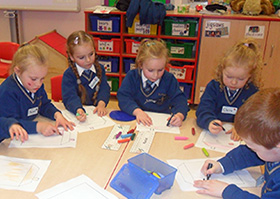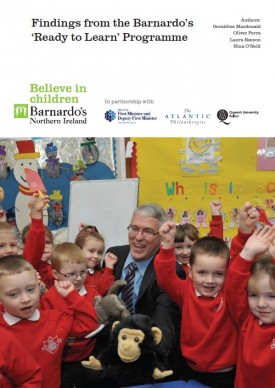Ready to Learn: Working in Partnership with Schools and Families to Help Raise Achievement
Resource type: Research Report
Institute of Child Care Research, Queen’s University Belfast |
Completing school is a fundamental task in order to succeed in life. Yet too many children from disadvantaged backgrounds fall behind soon after they start school and never catch up. A programme designed to help young children get the start they need has shown promising results.
Ready to Learn is an after school literacy programme that targeted both children and parents from poor areas in Northern Ireland. Carried out by Barnardo’s NI, the programme was subject to a rigorous randomised control trial. The evaluation found positive outcomes on measures of reading and problem behaviours while showing mixed results on other measures. Overall, the evaluation found that Ready to Learn may be able to make a difference on children’s reading in contrast to other after school literacy programmes. Because reading skills are so crucial in improving the trajectory of children’s lives, this is an important finding.
- Policy Briefing (PDF)
- Evaluation Summary (PDF)

The Situation
Children who do not reach their educational potential are at a significant disadvantage in completing school, competing for jobs, and participating fully in society. Despite improvements in recent years, almost one in six children in Northern Ireland leaves primary school without achieving their expected level in English and Maths. The picture becomes worse as children progress through schools and enter adulthood. A long-standing and sobering statistic is that a quarter of adults in Northern Ireland lack basic literacy and numeracy skills.
The Work
The youth-serving organization Barnardo’s NI wanted to improve literacy among disadvantaged children in order to help them successfully complete more years of schooling. Following a survey of 1000 school children and review of international literature, Barnardo’s NI created the Ready to Learn programme, which initially ran from 2010-2013 and was funded by Atlantic.
Ready to Learn has two key components:
- For young children—an after-school programme for 1 hour three days per week that focuses on speaking, reading, and writing. It seeks to help children develop a love of learning while also promoting the social skills needed for success in school.
- For parents/carers—a range of activities and support to help them engage in and support their child’s learning.
Ready to Learn was available to all children in a participating grade. Some 300 children started in the programme in Primary 1 (ages 4-5), which continued for three years. Attendance was not compulsory but encouraged by school and programme staff. Schools were all located in disadvantaged areas.
“When you grow up, you’ll know how to read and no-one will have to help you.’
– Participating child in Ready to Learn
The Findings

The Institute of Child Care Research at Queens University Belfast carried out an independent evaluation of the Ready to Learn programme. The evaluators used a cluster randomised trial design to assess the impact of Ready to Learn on children’s achievement and other outcomes. Nine primary schools taking part in the Barnardo’s NI Ready to Learn programme were compared with seven similar schools not receiving the additional support.
In 2014, researchers reported the following key findings:
- Children’s attendance for the three years was high and remained consistent. Ready to Learn was not compulsory and as a new programme it was unknown how many parents would agree to their children attending the after-school programme. But almost all parents wanted their children to participate. Attendance averaged 76% for the three years.
- The results of the evaluation were mixed but overall they pointed to a positive impact of Ready to Learn on children’s reading achievement. Not all of the measures used were direct gauges of reading because of the young age of children and the likelihood that a high percentage were starting from a low base. It was encouraging therefore that Ready to Learn had the most impact on measures that directly tested reading skills.
- Children in the Ready to Learn schools:
- Performed better overall than those in the control schools on the measure of reading comprehension. The effects were not large, but the evidence suggests that it is unusual for an after school programme to so clearly demonstrate effects on reading skills.
- Outperformed those in the control schools on linguistic phonics in a ‘decoding’ test. This is an important reading skill. Improving children’s linguistic phonics at these age levels can lead to direct improvements in oral reading ability and reading comprehension.
- Did no better than children in the control schools on a second decoding test. Children in both groups improved each year.
- Did no better than children in control schools in relation to receptive vocabulary, which is a proxy measure for monitoring children’s oral language development. A concerning finding is that children in both the Ready to Learn and control schools performed below the level expected for their age by the end of the evaluation.
- Children in Ready to Learn schools were less likely to display problem behaviour at the end of the study compared to those in the control group. The results are encouraging and even a modest impact on the lessening of children’s problem behaviour may be important but results need to be replicated and extended.
- Ready to Learn children did not out-perform those in the control group in relation to the development of emotional skills. The measurement used assesses children’s ability to recognise emotional arousal and distinguish between feelings of being ‘happy,’ ‘sad,’ ‘angry,’ and ‘scared.’
- By the end of the study, children in Ready to Learn schools were outperformed by those in control schools in relation to social skills. This measure consists of 34 items that describe adaptive or positive behaviours (e.g., ‘is cooperative,’ ‘follows directions,’ ‘shows self-control.)
Conclusion
The results of this cluster randomised trial are complex but promising. The findings suggest that Ready to Learn may be able to make a positive difference to children’s reading in contrast to other after school literacy programmes which have found few encouraging results.
While the findings were mixed, this in part reflects the challenges of assessing the impact of a literacy programme on such young children. The most important differences were in those measures that directly assessed ‘literacy behaviour’—reading fluency, reading comprehension, and decoding. Given the importance of reading to improving the life chances of children, this is an important finding.
‘I hadn’t thought about how important it was to have a consistent routine, not just for her but for me as well. The facilitator was great in showing me how important this was.’
– Participating parent in Ready to Learn
Next Steps
Since the end of trial demand and interest in the programme has been positive. One third of the original schools are continuing Ready to Learn and nine new schools have begun using the programme. Barnardo’s NI is now delivering the after school programme in 12 primary schools to 250 children.
Funding is coming from a variety of sources including school budgets, the Community Education Initiatives Programme from the Department of Education, or external funding obtained by participating schools.
Barnardo’s NI is also working with schools to develop more sustainable and cost effective ways of delivering and sharing the programme. For example, schools are experimenting with delivery using a combination of Barnardo’s NI and school staff, piloting a ‘targeted’ version of the programme to a smaller group of children, and delivering Ready to Learn with children from two different schools coming together. Two of the original schools have also expanded the programme to include additional days for different year groups.
Download the Reports
- Policy Briefing (PDF)
- Evaluation Summary (PDF)
Barnardo’s NI is an Atlantic grantee.
